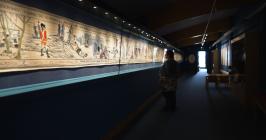Content can be downloaded for non-commercial purposes, such as for personal use or in educational resources.
For commercial purposes please contact the copyright holder directly.
Read more about the The Creative Archive Licence.
Description
Lede
The landing of French soldiers near Fishguard in 1797 has been remembered as the Last Invasion of Britain.
Story
The ‘Last Invasion of Britain’: was the last occasion on which enemy troops set foot on British soil. It took place in the context of other planned, but unsuccessful, landings in Ireland and other parts of the British coast, which the French hoped would distract and weaken the British forces. The following year French troops did land at Killala Bay on the west coast of Ireland, too late to support an Irish uprising aimed at throwing off British power. In Ireland there was considerable support for the French, not only from the United Irishmen but from large areas of the rural, Catholic population, whose lives were severely and often cruelly restricted under British rule. Welsh radicals supportive of the ideals of the revolution did not have a similar network, nor a similar groundswell of support. Memories and traditions recollecting the ‘Year of the French’ are thus markedly different in Wales and Ireland.
On the afternoon of 22 February 1797, weeks after a failed attempt to land French soldiers at Bantry Bay on the west coast of Ireland, General Lazare Hoche sent a fleet from Brest under the command of Irish-American William Tate. The aim was to attack the west coast of Britain and distract the government from sending reinforcements to Ireland. Unable to land near Bristol, the four warships continued up St George’s Channel and anchored off the point of Carregwastad just south of Fishguard.
Through the night of 22 February 1797 some 1250 soldiers, arms, supplies and munitions were brought ashore here. Known as the Légion Noire (‘Black Legion’) because they wore re-used British uniforms dyed in dark colours, they were a mixture of trained soldiers and irregulars, including convicts and deserters. This impressive operation – the coast here is incredibly steep and rocky – initiated a series of events culminating in a French surrender two days later. A now weathered memorial stone was erected here in 1897.
The French landing set off a panic described by a witness ‘fel tan gwyllt yn difa sofl’ (‘like a wildfire burning up stubble’). On 23 February the French troops took over Trehowel farm and Tate set up his base there. The hungry soldiers had unrestrained access to the well-stocked larders and cellars of the owner, John Mortimer: this was widely believed to have contributed to a rapid breakdown in discipline. A local ballad describes them:
Dwyn yr yde o’r ysguborie
A gwartheg a’r lloie’n llu;
Mynd i’r seleri (naws hwyl arw)
[I] gael cwrw croyw cry’.
They stole the corn from the barn
And many cattle and calves
Went down to the cellars
To get bright strong beer.
Tate sent envoys to Fishguard to negotiate a conditional surrender. The British forces declined Tate’s offer and insisted on a complete surrender, giving the French troops until 10 am the following day to comply. On the morning of the 24 February the French soldiers were brought around the head in boats and laid down their arms in formal surrender. They were then marched to prison in Haverfordwest, where a contemporary witness describes them as hungry and confused. Tate and many of the invading force were eventually exchanged for British prisoners. James Baker’s striking images of the troops gathered on Goodwick Sands appeared very soon after the event, and the site of the ‘Last Invasion’ rapidly became a tourist attraction.





Do you have information to add to this item? Please leave a comment
Comments (0)
You must be logged in to leave a comment